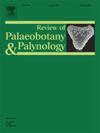Oligocene and early Miocene charophyte flora from the Sivas Basin (Central Anatolia, Türkiye). Biostratigraphy and palaeobiogeography
IF 1.7
3区 地球科学
Q2 PALEONTOLOGY
引用次数: 0
Abstract
A rich charophyte assemblage is described and illustrated here from the Upper Paleogene-Lower Neogene lacustrine and palustrine rocks of the Sivas Basin (central Anatolia, Türkiye). The flora was extracted from 3 stratigraphic sections located in the eastern part of the Sivas Basin in the localities of Emirhan, Eğribucak, and Taşlıdere. Nine species belonging to two families (Characeae and Raskyllaceae) are identified here. The Characeae species from Emirhan and Taşlıdere (Emirhan and Karayün formations) are diverse and the assemblage is represented by Sphaerochara ulmensis, Sphaerochara sp., Chara molassica var. notata, Ch. cf. pappii, Chara sp., Hornichara sp., Lychnothamnus pinguis forma major and Nitellopsis (Tectochara) merianii. Several of these species display a wide biostratigraphic range in Europe spanning from the early Oligocene to middle Miocene. The co-occurrence of L. pinguis and Ch. molassica var. notata suggests that both the Emirhan and Karayün formations are upper Rupelian–lower Chattian (∼ 30–25 Ma). In terms of paleogeography, this flora displays a clear European affinity. The charophyte flora recovered from the Eğribucak locality (Unit 3 of the Eğribucak Formation) is composed of the single species Rantzieniella nitida which displays a limited biostratigraphic range within the Aquitanian (early Miocene). Accordingly, Unit 3 of the Eğribucak Formation can be correlated with the homonymous European charophyte biozone as well as with the Mammal Neogene Zones MN1–2 (∼ 24–21 Ma). Moreover, the occurrence of this index species in central Anatolia confirms its Eurasian distribution highlighting the usefulness of R. nitida in intercontinental basin correlation.
求助全文
约1分钟内获得全文
求助全文
来源期刊
CiteScore
3.50
自引率
21.10%
发文量
149
审稿时长
6 months
期刊介绍:
The Review of Palaeobotany and Palynology is an international journal for articles in all fields of palaeobotany and palynology dealing with all groups, ranging from marine palynomorphs to higher land plants. Original contributions and comprehensive review papers should appeal to an international audience. Typical topics include but are not restricted to systematics, evolution, palaeobiology, palaeoecology, biostratigraphy, biochronology, palaeoclimatology, paleogeography, taphonomy, palaeoenvironmental reconstructions, vegetation history, and practical applications of palaeobotany and palynology, e.g. in coal and petroleum geology and archaeology. The journal especially encourages the publication of articles in which palaeobotany and palynology are applied for solving fundamental geological and biological problems as well as innovative and interdisciplinary approaches.

 求助内容:
求助内容: 应助结果提醒方式:
应助结果提醒方式:


